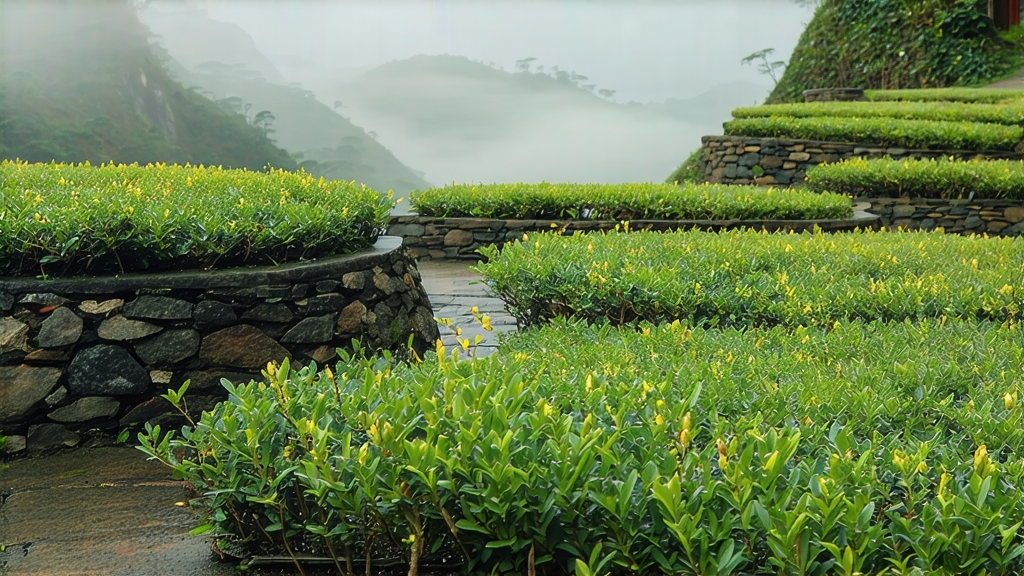
Tucked high above the Sichuan basin, where the Himalayas begin their gentle descent toward the Chengdu plain, lies Meng Ding Mountain, a ridge so often draped in fog that local poets claim it “floats one realm closer to heaven.” It is here, among terraced gardens first planted during the Western Han dynasty, that Meng Ding Huang Ya—literally “Yellow Bud from Meng Ding”—was born. Unlike the better-known green teas of neighbouring Emei or the dark bricks of Yunnan, this yellow tea remained for centuries a court secret, carried in bamboo tubes along the Min River and presented to emperors who believed its golden liquor could “rinse the dust of mortality from the throat of power.” Today, only a few hundred kilograms leave the mountain each spring, making Meng Ding Huang Ya one of the rarest styles in the six-family Chinese tea taxonomy, yet its story offers a luminous window into the alchemy of micro-oxidation, mountain terroir, and human patience.
Historical whispers
The first verifiable record appears in the Chronicles of Sichuan Roads (益部方物略记, 1082 CE), which lists “Meng tribute: bud-closed, three-day sealed, colour of goose down, scent of distant orchid.” By the Ming dynasty the tea had become so coveted that Chongzhen Emperor (r. 1627-1644) decreed every picked bud be wrapped in silk printed with the imperial five-clawed dragon, a packaging extravagance that doubled the tax on the county. When the Qing replaced the Ming, Manchu nobles—accustomed to the malt of Pu-er—found the tea “too delicate for horseback,” and Meng Ding Huang Ya retreated into monastic circles where monks used it to stay alert during 49-day meditation retreats. Thus the technique survived not in imperial courts but in the muscle memory of a handful of cloistered families who still speak the old Ba-Shu dialect.
Micro-terroir in 800 m of altitude
Meng Ding is not a single peak but a 10-km limestone spine averaging 1 200 m elevation. Its northern face captures the tail end of the Tibetan Plateau’s cold air, while the southern slope inhales humid Sichuan basin breezes. The resulting diurnal swing—often 12 °C within one afternoon—coaxes the tea bush to store extra L-theanine in the bud, giving later infusions a brothy sweetness reminiscent of white miso. Soils are a crumbly shale rich in selenium and fluorine; locals insist the fluorine is why their monks keep their teeth into old age, a claim modern dental surveys of the region intriguingly support. Only the indigenous small-leaf cultivar (Camellia sinensis var. sinensis ‘Gan Zi #1’) is used; its leaves are 30 % smaller than the Fuding Da Bai clone favoured for silver-needle whites, allowing faster and more even yellowing.
Harvest calendar: the 8-day window
Spring thaw arrives late; buds sit tight until the qingming festival, usually 4–6 April. Pickers climb the terraces before 06:00 while dew still pins the outer scale to the bud, a natural “wet-wrap” that prevents mechanical bruising. The pluck standard is fanatically strict: one unopened bud topped by an half-unfurled leaf no longer than 2.5 cm, a joint length locals call “sparrow’s tongue.” Experienced pickers can gather just 400 g per hour; 50 000 such sets yield 1 kg of finished tea. If rain falls on the fourth day, the entire harvest is abandoned, because surface moisture will later trap carbon dioxide inside the yellowing pile and create off-putting cooked-corn notes.
Craft: the dance of killing green and waking yellow
Step 1: Sha Qing (kill-green)
Leaves are tumble-fired in bamboo-drums rotated over a 160 °C charcoal bed of Japanese red-pine. The goal is not full de-enzyming—as in green tea—but a 70 % reduction in polyphenol oxidase, leaving just enough latent activity for the later “sealed yellowing.” The firing lasts 3 min; masters listen for the sound of raindrops on a tin roof—tiny pops that signal evaporation of the bud’s cuticular wax.
Step 2: Re Damp & Pile
While still warm (≈ 45 °C), the leaves are quickly sprayed with 3 % ambient-temperature mountain